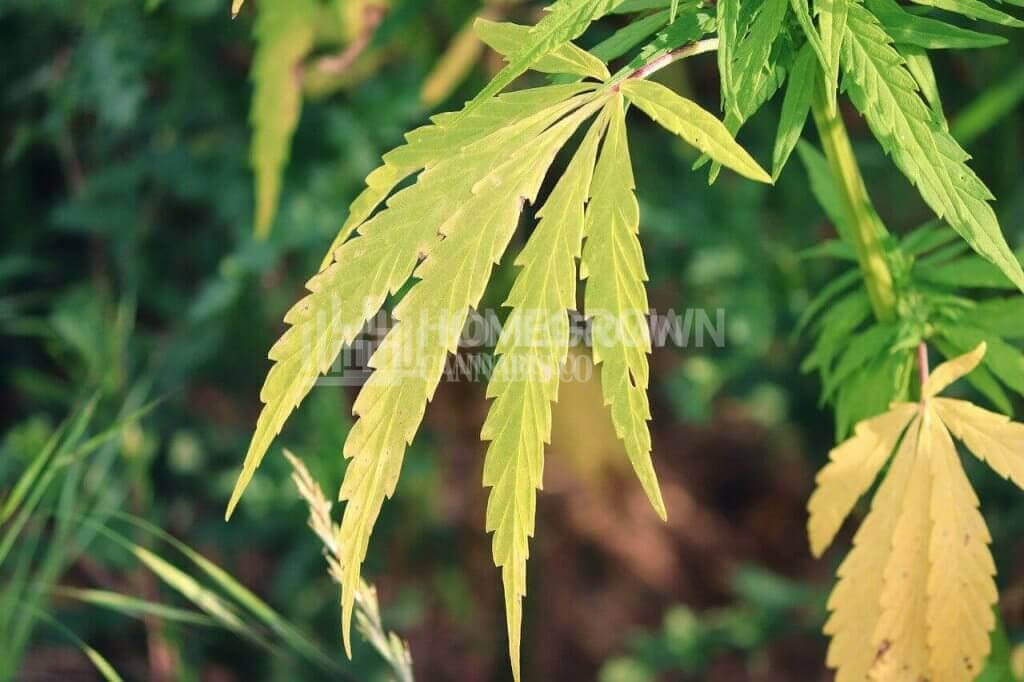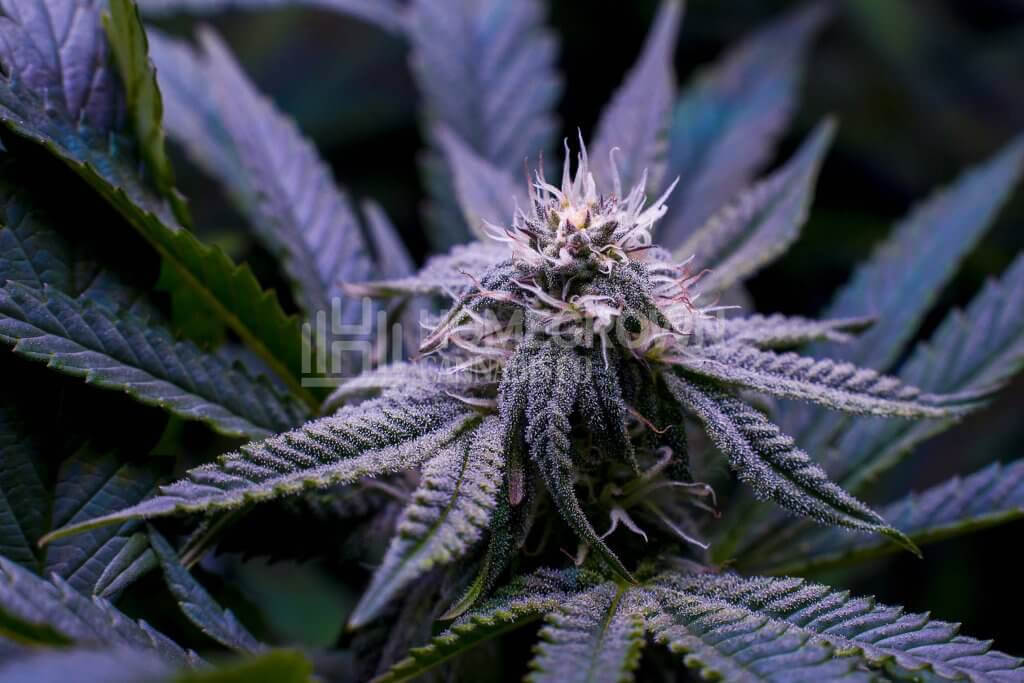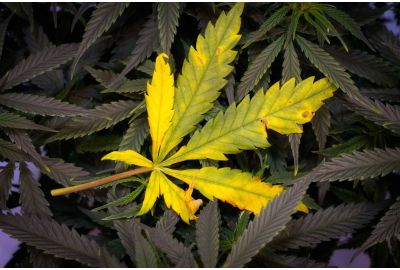Cannabis Light Burn: Everything You Need To Know
Too much of anything is bad. Just because a light is powerful doesn't mean it's good. Cannabis light burn can be tough to identify but occurs easily due to the wide range of lighting solutions used by growers who are oblivious to the dangers of intense illumination.
It's common knowledge that LEDs came to counter heat problems brought about by traditional indoor grow lighting systems, forgetting that light intensity is also something to consider.
The illumination can be too much or too little, meaning your plant doesn't get the right amount of energy. Outdoor cultivators don’t need to worry because the sun is too far away to cause leaf burn issues.
Read on to see how you can spot cannabis light burn and the type of light required to reduce the chances of damage to your plants.

What happens when you give cannabis too much light?
Indoor grow lights cause cannabis light stress in two ways.
- The leaves burn if the light's too intense, making the chlorophyll in the foliage degrade and possibly become white.
- The whole plant withers if the light makes the grow room too hot, forcing the leaves to claw upwards and brown.
Many growers switched to LEDs to avoid heat issues. However, this has come at the cost of light stress becoming more common nowadays than heat stress.
What happens when you give cannabis too much light during flowering?
Intense light during this phase results in bleached buds. The pure white color might seem attractive, but the lack of potency, aroma, and flavor renders the nugs useless. Too much light during flowering makes the terpenes degrade.
What is cannabis light burn?
Sometimes we call cannabis light burn light bleaching because a tell-tell sign of this problem is your buds developing a white color when affected.
Light-induced leaf burn is more common nowadays than heat burn because many cultivators are switching to high-efficiency LED lights for cannabis that produce less heat for more light.
As a result, many growers wrongfully put the LED light close to the plant, assuming that it's safe when it's not. Don't be surprised if you see symptoms like your leaves becoming scorched, not by heat, but by light.
Marijuana light burn affects chlorophyll, which is the green pigment inside every plant that uses photosynthesis. Chlorophyll is sensitive to light, but too much illumination degrades it, causing it to bleach. As a result, the affected leaf looks like it's scorched in patches, usually starting from the edges.
Seedling light burn
The seedling stage is a delicate period in your plant's life. At this phase, the cannabis crop’s more vulnerable to light burn. There’s very little foliage as it emerges from the soil and opens its first leaves called dicotyledons.
The first leaves are photosynthetic and capable of capturing light and converting it to energy. A pair of true leaves develop in 2 to 3 weeks from seed and take over the photosynthesis job. Light intensity is vital for seedlings because if it's too dim, your fledgling plant stretches out and becomes weak and flops over since the stem can't support its length.
However, the lights (including LEDs) shouldn't be too close to cause light burn to seedlings even if they emit very little heat.
You can nurture seedlings without grow lights if you have enough sunny space on your porch or windowsill to avoid seedling light burn. Seedlings don't need too much light.
Cannabis leaf burn
Cannabis leaf burn seems to mimic what you'd find with a deficiency issue. The main differences are that you'll notice the leaves affected by burns are harder to remove. The symptoms also display themselves beginning at the top where the light comes from.
The tips of the leaves stressed by light are more yellow, while the veins usually retain their green color.
Look at the PPFD readings of your light, where it shows what distance above the canopy is safe for your plants to prevent leaf burn. Follow the instructions of the grow light manufacturer or test the PPFD for yourself. Note that credible PPFD meters are expensive and not something regular home growers buy.

Cannabis light stress symptoms
Signs of cannabis light burn include the leaves yellowing, burning, curling, and decaying. Yes, these symptoms are similar to what you'd find with a nitrogen or cal-mag deficiency issue, but the key differences are:
- Leaves stressed from light burn are harder to pull off compared to how they die and fall off effortlessly due to cannabis deficiencies. Light burned leaves also retain their green pigmentation on their veins.
- Deficiency symptoms start to show in lower growth, but yellowing leaves from marijuana light burn start from the top of your plant because that's where the light source is.
Knowing the difference helps you avoid adjusting pH or flushing your cannabis plant in vain, hoping to fix deficiencies when you encounter symptoms of leaf burn.
A definite way of recognizing too much light during flowering is bleached buds. Affected nugs might look swell with their pure white “albino” colors, but they'll have lost a significant chunk of potency. Bleached buds also have an undesirable taste and scent.
Cannabis light stress symptoms don't occur overnight. You may be weeks into growing and then suddenly see your plants look as if they’re sunburned.
Just like you, plants can deal with a few days of intense lighting, but if it continues for too long—like a whole week—then it’ll feel the effects. You may start to see marijuana light burn symptoms manifest themselves close to harvest, meaning yield isn't affected much.
How to prevent light burn on weed plants?
Make sure you place the grow light where the manufacturer recommends to reduce the chances of burnt weed.
Check the PPFD of your grow light. PPFD (photosynthetic photon flux density) measures how many photosynthetically usable photons hit some distant surface. PPFD is currently the most useful term when discussing and comparing different light sources for plants.
Using watts or lumens to set up a grow room is okay, but PPFD is a better measurement because it considers the light the plant needs for optimal growth.
Here are the recommended PPFDs to avoid light burn on cannabis plants.
| Plant stage | PPFD |
| Seedling, clones | 250–400 |
| vegetative | 400–600 |
| flower | 600–900 |
You can increase PPFD above what's recommended by supplementing CO2 for cannabis into your grow room, but there are limitations.
Using a PAR or lux meter, you'll notice the light is more intense towards the central zone. This is also where burnt weed symptoms usually start to show.
To keep learning about this, read our report on "PPFD for autoflowers".
Can you fix burnt weed?
Unfortunately, you can't cure light burn on cannabis, but you can prevent it. Scorched leaves begin to decay, so you have to remove them to stop the spread of diseases. Leaves that aren't burnt completely can remain functional if you don't think they’re a liability.
Avoid further damage
All grow lights produce heat, but HID lamps generate more than fluorescent lights or LEDs. High temperatures usually affect your marijuana plants if the grow light’s close to the canopy, leading to burnt weed. Here’s what you can do to put an end to such a problem:
- Move the light away from your plant to prevent further destruction. You can also remove some of your lights' bulbs to reduce the intensity. Some LEDs have the option to dial down the strength of their brightness.
- Train your plant to not grow too high and close to the light by bending the branches—consequently reducing the chances of marijuana light burn. Many cultivators like to use the Screen of Green (ScrOG) to reduce the plant's height and spread the canopy wider for more yields.
- You can be proactive in your approach to dealing with cannabis light stress by looking at par meters. Check the manufacturer's light specifications and see if it's within range of what your cannabis plant requires. If this information isn't available, then you can measure the ranges by yourself.
Cannabis light stress can be specific to genetics, similar to how some people tolerate sunburn longer than others. Some strains, such as hazes and sativas from the equator, are more resistant to heat and enjoy more sunlight.
Don't be shocked when you plant a different strain using your usual grow light and find it grows taller than expected, or notice that the light’s too intense or insufficient.

Nitrogen deficiency vs. light burn
Cannabis light stress is often mistaken for a nitrogen deficiency because they exhibit similar symptoms of yellowing leaves. The easiest way to differentiate is that deficiencies usually start from the bottom of the plant, while light burn on cannabis starts from the top and moves down.
Burnt leaves also feel crispy and are harder to pluck from the crop because their green veins retain moisture. Leaves on a plant suffering from nitrogen deficiency are easy to pluck out and usually fall off from the plant readily without your intervention.
Heat stress vs. light stress
Excess heat can ravage the whole plant. Too much light starts to affect the herb from the top, hitting the canopy and bleaching your succulent buds during flowering.
Plants can't tolerate extreme heat and might wither and die if the problem persists. Too much light on cannabis can damage the buds and burn its leaves, but excess heat is undeniably worse.
Bleached buds lose their potency because their cannabinoids dissipate. Unaffected buds are still good to smoke, though.
You must raise the lights to prevent burnt weed, but keep them low enough for adequate illumination. You can control grow room temperatures through various means, such as increasing airflow in your grow room for heat to move out efficiently.
Always pay attention to the temperature range in your grow room, ensuring the strains you're growing can handle it. Go through your grow light manual to check its PPFD to see where you’re supposed to suspend your light above your canopy. Alternatively, you can seek this information online to prevent cannabis light stress issues.
Here's a general guide for light distances to ward off heat issues in your grow room:
| Light type | Power in watts | Distance from the plant in inches |
| MH and HPS | 400W | 12–19 |
| 600W | 14–25 | |
| 1000W | 16–31 | |
| LEC/ CMH | 315W | 18–20 or more |
| 630W | 24–26 or more | |
| LED | 240–400W | 16–30 |
| 450–550W | 20–30 | |
| 600–850W | 24–36 | |
| 900W+ | 26–42 | |
| Fluorescent (CFL, T5) | Hardly emit any heat | Do a hand test |
FAQs about cannabis light burn
Here are answers to the most common questions we hear regarding cannabis light burn.
Is too much light bad for cannabis plants?
Yes, excessive light can harm your cannabis plant. Light serves as food for the crops, and the leaves are like solar panels. Chlorophyll in the foliage converts nutrients to sugars using light.
You can take advantage of the excess light by increasing carbon dioxide in your room. However, you can only go so far before you have to deal with cannabis light burn.
Can you burn plants with LED lights?
LEDs don't generate a lot of heat but can produce too much light. LED light burn is very possible and often overlooked by growers.
You'll find many modern LED grow lights that have adjustments for intensity to counter this problem. Avoid the temptation of lowering LED lights even though they don't get hot. Their light can damage plants quickly. You may even start to see cannabis light stress symptoms after only a day.
Can LED grow lights burn seedlings?
Yes, intense LED light can lead to seedling light burn. On the other hand, seedlings can grow weak and spindly if the light is too far from them. Hover your hand over the top of the seedling to the point where you're barely touching it.
Heat from light shouldn't be so high that it's unbearable to the back of your hand. Raise the lighting if you feel the LED light burn is too much. Don't keep the lamp too close if it's above the recommended PAR values for your fragile seedlings. It’s a delicate balance, and a PPFD of between 250–400 is ideal for cannabis plants.

Too much of anything is bad
Now you won't waste time fixing other problems when you see symptoms of cannabis light burn because you know what to look out for. You’ve learned that it's better to be proactive in stopping light burn issues by looking at the specifications of your grow light.
Don't confuse leaf burn symptoms with heat stress or deficiencies. A surefire way of knowing your plants are suffering from light stress is bleached buds and yellowing leaves, starting from the top of your canopy.
We have many more guides like this on our troubleshooting page to help you with any other problems you might encounter on your journey to cultivating scrumptious buds.
About the author: Parker Curtis
Parker Curtis has around a decade of cannabis-growing experience, specialising in soil-less and hydro grows. He’s mastering outdoor, greenhouse, and indoor grows.
